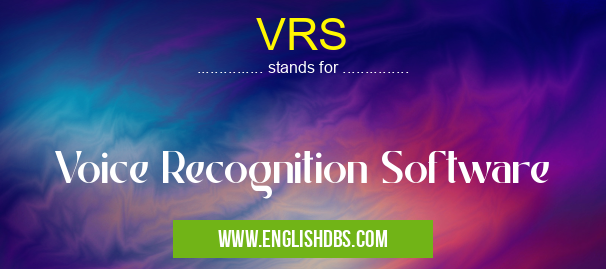What does VRS mean in SOFTWARE
VRS stands for Voice Recognition Software. It is a technology that allows computers to recognize and interpret spoken words. VRS is typically used to transcribe spoken audio into text, but it can also be used for other purposes, such as controlling devices or providing customer service.

VRS meaning in Software in Computing
VRS mostly used in an acronym Software in Category Computing that means Voice Recognition Software
Shorthand: VRS,
Full Form: Voice Recognition Software
For more information of "Voice Recognition Software", see the section below.
How VRS Works
VRS typically works by using a combination of acoustic models and language models. Acoustic models are used to identify the sounds that are being spoken, while language models are used to determine the most likely sequence of words that could have produced those sounds.
Types of VRS
There are many different types of VRS, each with its own strengths and weaknesses. Some of the most common types of VRS include:
- Speaker-dependent VRS: This type of VRS is trained on the voice of a specific speaker. This makes it very accurate for that speaker, but it cannot be used to recognize the speech of other speakers.
- Speaker-independent VRS: This type of VRS is trained on the voices of many different speakers. This makes it less accurate than speaker-dependent VRS, but it can be used to recognize the speech of any speaker.
- Noise-canceling VRS: This type of VRS is designed to work in noisy environments. It uses special algorithms to filter out background noise, making it easier to recognize speech.
- Continuous VRS: This type of VRS can recognize speech that is spoken continuously, without pauses. This makes it ideal for use in dictation and other applications where it is important to capture all of the spoken words.
Benefits of VRS
VRS offers a number of benefits, including:
- Increased productivity: VRS can help to increase productivity by automating the process of transcribing spoken audio into text. This can free up employees to focus on other tasks.
- Improved accuracy: VRS is typically more accurate than human transcriptionists, which can help to improve the quality of transcribed documents.
- Reduced costs: VRS can help to reduce costs by eliminating the need for manual transcription.
Essential Questions and Answers on Voice Recognition Software in "COMPUTING»SOFTWARE"
What is VRS?
Voice Recognition Software (VRS) is a type of speech-to-text technology that allows users to control their devices and applications using spoken commands. It converts spoken words into text, enabling hands-free interaction with computers, smartphones, and other devices.
How does VRS work?
VRS utilizes advanced algorithms to analyze sound waves from spoken words. It compares the input to a database of known words and phrases to identify the most likely match. The recognized text is then displayed on the screen or used to execute commands.
What are the benefits of using VRS?
VRS provides numerous benefits, including:
- Enhanced accessibility: Allows individuals with physical disabilities or language barriers to interact with technology more easily.
- Improved productivity: Enables multitasking and hands-free control, freeing up time and reducing distractions.
- Reduced errors: By eliminating the need for manual input, VRS minimizes the risk of errors or typos.
- Increased efficiency: Simplifies tasks that require extensive typing or navigation, enhancing overall efficiency.
What are some common uses of VRS?
VRS is commonly used in a wide range of applications, such as:
- Dictation software: Allows users to transcribe spoken words into text, making it easier to create documents, emails, and presentations.
- Voice-controlled devices: Enables users to control smart home appliances, set reminders, and access information using spoken commands.
- Customer service applications: Provides automated assistance to customers, resolving queries and providing information hands-free.
- Medical transcription: Helps healthcare professionals transcribe patient records, notes, and reports more efficiently and accurately.
What are the limitations of VRS?
While VRS offers numerous advantages, it does have some limitations:
- Accuracy: VRS is not always 100% accurate, especially in noisy environments or when dealing with accents or unfamiliar words.
- Training: Some VRS systems require training to optimize accuracy, which can be time-consuming.
- Vocabulary: VRS systems may have limited vocabulary, which can make recognizing specialized or technical terms challenging.
How can I improve the accuracy of VRS?
To enhance the accuracy of VRS, consider the following tips:
- Speak clearly and at a normal pace: Avoid mumbling or speaking too quickly.
- Use correct pronunciation: Pronounce words distinctly, especially those that sound similar.
- Minimize background noise: Choose a quiet environment to reduce interference.
- Train the VRS system: Provide the system with samples of your speech to improve its recognition ability.
Final Words: VRS is a powerful technology that can be used to improve productivity, accuracy, and cost-effectiveness. As VRS technology continues to improve, it is likely to become even more widely used in a variety of applications.
VRS also stands for: |
|
| All stands for VRS |
